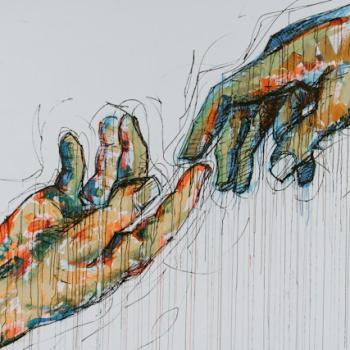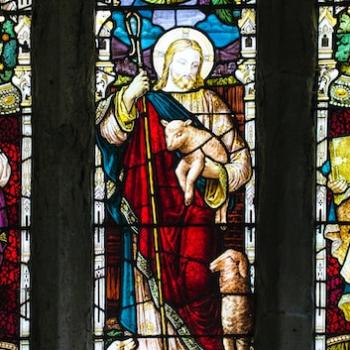
Why all the hate for “Doubting Thomas?” A major player in last Sunday’s gospel reading, he’s commonly thought to be somewhere between Meryl Streep in The Devil Wears Prada and Angelina Jolie in Maleficent. In other words, no high marks. Personally, I’m a little bit in love with him. Here’s why.
In John’s gospel shortly after Jesus has risen, the disciples are huddled together in a room, and Jesus appears. Thomas wasn’t present then, so when he did return, he couldn’t be persuaded to believe such outrageous tales about Jesus’ appearance after death. “But he said to them, ‘Unless I see the mark of the nails in his hands and put my finger into the nail marks and put my hand into his side, I will not believe’” (John 20: 25).
Watch Me Pull a Rabbit Out of My Hat
Later, Jesus comes back to the same room with the same crew, but this time Thomas is present. Jesus allows Thomas to touch the gash in his side and trace the scars on his hands. And then there’s that line in the gospel story that – I’ll admit – I hate. “Jesus said to him, ‘Have you come to believe because you have seen me? Blessed are those who have not seen and have believed’” (20: 29).
So, Thomas is the antagonist here, right? He’s the anti-hero who lacks faith, the very epitome of whatever everyone else should seek to rise above, correct?
Sorry, no. I object. And here’s why.
First, the details of the story are . . . peculiar. The first time Jesus appears, the writer takes great care to note that the room was locked. And again, the second time the doors are locked again.
Really? So, we are supposed to be amazed by this? Let’s think about this for a minute. He endures betrayal, great suffering, and an excruciating death, but then in three days, his friends and disciples experience him as alive again. Rising from the dead? Well sure, that’s pretty cool . . . but what’s more, he got into a locked room! Twice, even! So the whole resurrection thing is nice but outmaneuvering a padlock is the real miracle? Seriously?
C’mon now!
That’s not the only part that’s strange. Let’s think about what we know of Jesus from the gospels. Do we really think he would intentionally shame Thomas in front of his friends? Personally, I find that unlikely.
Sure, sure, I can hear the rebuttal now: “He only said that because he was trying to teach a lesson.” Nope, I have to call foul. I’m a teacher myself, and I know that the good ones don’t make examples of the students who don’t ‘get it.’ The only explanation that makes sense to me is that the writer of John’s gospel put these words in Jesus’ mouth to make a point, which is perfectly fine with me.
John’s gospel – interestingly, the only one that contains this story – was written later than the other synoptic gospels, long after those who knew Jesus in the flesh had died. His audience likely included many people who were “Doubting Thomas’” themselves. After all, they didn’t have the first hand experiences of those who knew him personally. I think the “kudos to those who believe without seeing” speech was a rhetorical strategy the gospel writer used to convince those who were unsure, not a transcript of a historical conversation.
Worth Rethinking?
So for millennia, we have congratulated ourselves for our superior righteousness in believing things without asking for proof. We put this type of uncritical assent on a pedestal and made it the measuring stick of worthiness. And we gave it a name – “faith.” I find that just shy of tragic. I have to ask – what virtue is there is believing in things without evidence? If the principles we live by in other areas of our lives are forbidden when it comes to faith, then it seems to me there is either a problem with the principles . . . or the faith.
In my view, “Doubting Thomas” has gotten a profoundly bad wrap. He asked to see the scars and touch the wounds. But isn’t that what life as a human is? It’s seeing the scars and touching the wounds. It’s acknowledging the pain. And it’s recognizing that the timid, purple-ish canopy of shockingly new skin that slowly, slowly, slowly replaces a once-angry wound is proof positive that, eventually, life wins. Death is not the end of the story. Wounds heal.
I applaud Thomas’ practical side. I’m actually a fan of his “show me the proof” questions. We have to use our own fingers to trace the scars of our own hurts and vulnerabilities that crucified us at fist but, in time, grew into something soft and new. This is how we bear witness to the truth of the Resurrection in our own lives. So there it is. I’m a little bit in love with Thomas.











